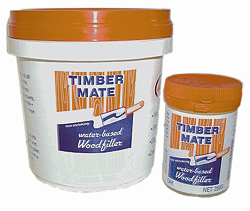
Barry Gork is a forty-one year old former woodworker who enthusiastically trumpets the wonders of Timbermate to North Americans. He’s got good reason to crow about it. After all, it’s already got an impressive following in Australia, where it commands the loyalty of some 90% of the putty, trowel filler and pore filler market.
As most woodworkers know, putty is a fairly thick material used to fill dings and dents, while pore filler is a much thinner version of the same thing, used to fill the large grain pores in woods like oak, ash, mahogany and walnut. Trowel filler is right in the middle; a semi-paste slurry used to fill the seams in wood floors during finishing. What’s remarkable is that one jar of Timbermate is all three products.
Even more amazing is how this fairly venerable and surprisingly versatile product made its way around the world to finally arrive here. The strange story begins with a British woodworker in the 1930s who was upset that the newly popular lacquer finishes did not work well with existing pore fillers. He joined together two materials that by all rights should not coexist, and the result was a multipurpose, waterbased, nontoxic filler that did not shrink, smell or crack, and was completely reversible. He started using it, and selling it to other woodworkers.
From there, the tale gets considerably more odd. One day while playing tennis, this British inventor had a heart attack. A man with the unlikely name of Sunny Suntup happened to be there, and helped save the man’s life. In gratitude, he gave Sunny the formula for his invention, exacting in exchange a promise that Sunny would fly him to Paris every year for the rest of his life. It seems he had a daughter there, and wanted to visit her annually.
Sunny moved to South Africa, formula in tow, and marketed Timbermate there in the 1960s and 70s, but emigrated to Australia in the early 1980’s. Coincidentally, Barry Gork and his cousin, Errol Mymin, also lived in South Africa. Errol, like Sunny, ended up in Australia, while Barry moved to Toronto, Canada.
As luck would have it, Sunny met Errol in 1990 and approached him about marketing Timbermate. Thoroughly impressed with the material, Errol sold his hardware store, partnered with Sunny, and started making Timbermate in his kitchen mixer. Using their savings to expand the company, they bought a factory and started manufacturing on a larger scale. It soon found its niche in the wood flooring business, in spite of the fact that it was originally developed for use on furniture, and eventually became the top dog in the Australian market.
Meanwhile, on this side of the ocean, Barry Gork got married and, in 1996, moved to Chicago where he opened a shop to pursue his dream of building custom furniture. His cousin Errol came to visit several times and, in 2001, suggested that Barry become the North American distributor for Timbermate. He said no, because he saw himself as a furniture maker, not a putty vendor, no matter how good the putty was.
Eventually, he started to see marketing Timbermate as a means to an end, and told his cousin “Let’s do it.” It hooked him. By 2002, he had relegated woodworking to the “hobby” position in his life, and committed to Timbermate as his day job. At first, he pitched it to the wood flooring market, where it was very well received, but because of his fondness for woodworking, he recently started introducing it to folks like us.
What’s so special about Timbermate? “It’s nontoxic, waterbased and odor-free,” Barry explained. “Unlike other fillers, it contains no oil, acrylic, or latex binder, so it is compatible with all finishes. It fills pores in one application and, once dry, won’t shrink, crack, or fall out, and it won’t even clog or gum up your sandpaper. When dry, it sands easily and quickly to a powder.”
The putty starts out just the right thickness for filling nicks and dings, but by adding water, you can make it into a trowel filler or pore filler. “Timbermate is more forgiving and easier to work with than normal pore fillers,” Barry continued. “Unlike most pore fillers, and putties for that matter, it is reversible. If you need to remove it for any reason, you can wipe it out with a wet cloth even after it is dry. In fact, if it dries in the container, you can reconstitute it with water, so there is never any waste.”
Timbermate comes in 14 colors, including a neutral tint base, but just in case you still don’t have exactly what you need, you can tint it with oil-based artist’s colors, waterbased artist’s colors, or universal tinting colors. “Being waterbased,” said Barry, “it is both temperature and humidity sensitive. It thins better when it is warm, so it is a good idea to mix it with warm water. It’s also freeze thaw stable. If it freezes, simply thaw it out and it is ready to go.”





